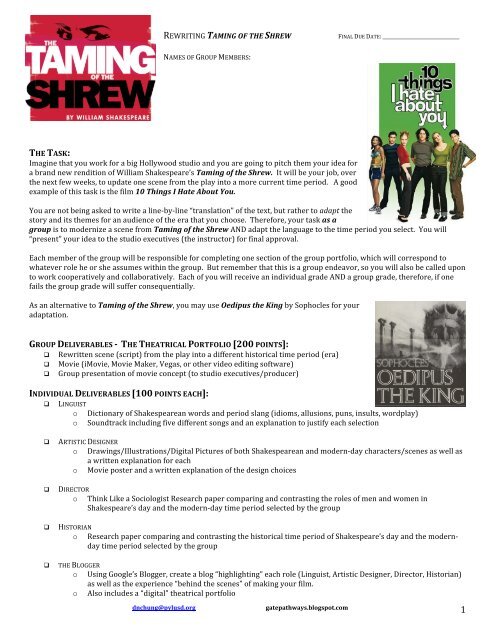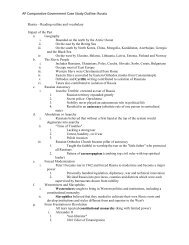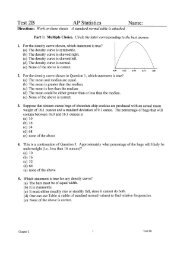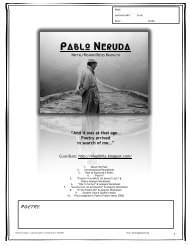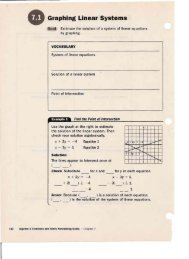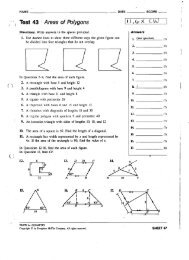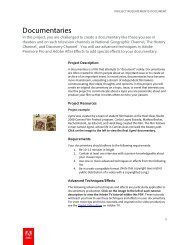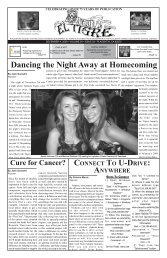ToTS PROJECT Rewriting Taming of the Shrew
ToTS PROJECT Rewriting Taming of the Shrew
ToTS PROJECT Rewriting Taming of the Shrew
You also want an ePaper? Increase the reach of your titles
YUMPU automatically turns print PDFs into web optimized ePapers that Google loves.
REWRITING TAMING OF THE SHREW FINAL DUE DATE: ________________________________ NAMES OF GROUP MEMBERS: THE TASK: Imagine that you work for a big Hollywood studio and you are going to pitch <strong>the</strong>m your idea for a brand new rendition <strong>of</strong> William Shakespeare’s <strong>Taming</strong> <strong>of</strong> <strong>the</strong> <strong>Shrew</strong>. It will be your job, over <strong>the</strong> next few weeks, to update one scene from <strong>the</strong> play into a more current time period. A good example <strong>of</strong> this task is <strong>the</strong> film 10 Things I Hate About You. You are not being asked to write a line-‐by-‐line “translation” <strong>of</strong> <strong>the</strong> text, but ra<strong>the</strong>r to adapt <strong>the</strong> story and its <strong>the</strong>mes for an audience <strong>of</strong> <strong>the</strong> era that you choose. Therefore, your task as a group is to modernize a scene from <strong>Taming</strong> <strong>of</strong> <strong>the</strong> <strong>Shrew</strong> AND adapt <strong>the</strong> language to <strong>the</strong> time period you select. You will “present” your idea to <strong>the</strong> studio executives (<strong>the</strong> instructor) for final approval. Each member <strong>of</strong> <strong>the</strong> group will be responsible for completing one section <strong>of</strong> <strong>the</strong> group portfolio, which will correspond to whatever role he or she assumes within <strong>the</strong> group. But remember that this is a group endeavor, so you will also be called upon to work cooperatively and collaboratively. Each <strong>of</strong> you will receive an individual grade AND a group grade, <strong>the</strong>refore, if one fails <strong>the</strong> group grade will suffer consequentially. As an alternative to <strong>Taming</strong> <strong>of</strong> <strong>the</strong> <strong>Shrew</strong>, you may use Oedipus <strong>the</strong> King by Sophocles for your adaptation. GROUP DELIVERABLES - THE THEATRICAL PORTFOLIO [200 POINTS]: Rewritten scene (script) from <strong>the</strong> play into a different historical time period (era) Movie (iMovie, Movie Maker, Vegas, or o<strong>the</strong>r video editing s<strong>of</strong>tware) Group presentation <strong>of</strong> movie concept (to studio executives/producer) INDIVIDUAL DELIVERABLES [100 POINTS EACH]: LINGUIST o Dictionary <strong>of</strong> Shakespearean words and period slang (idioms, allusions, puns, insults, wordplay) o Soundtrack including five different songs and an explanation to justify each selection ARTISTIC DESIGNER o Drawings/Illustrations/Digital Pictures <strong>of</strong> both Shakespearean and modern-‐day characters/scenes as well as a written explanation for each o Movie poster and a written explanation <strong>of</strong> <strong>the</strong> design choices DIRECTOR o Think Like a Sociologist Research paper comparing and contrasting <strong>the</strong> roles <strong>of</strong> men and women in Shakespeare’s day and <strong>the</strong> modern-‐day time period selected by <strong>the</strong> group HISTORIAN o Research paper comparing and contrasting <strong>the</strong> historical time period <strong>of</strong> Shakespeare’s day and <strong>the</strong> modern-day time period selected by <strong>the</strong> group THE BLOGGER o Using Google’s Blogger, create a blog “highlighting” each role (Linguist, Artistic Designer, Director, Historian) as well as <strong>the</strong> experience “behind <strong>the</strong> scenes” <strong>of</strong> making your film. o Also includes a “digital” <strong>the</strong>atrical portfolio dnchung@pylusd.org gatepathways.blogspot.com 1
STEP ONE: ADAPTATION OF A TAMING OF THE SHREW SCENE (OR OEDIPUS THE KING) Form groups <strong>of</strong> four (5 or 6 with teacher permission) for <strong>the</strong> duration <strong>of</strong> <strong>the</strong> project. As a group, pick a scene from <strong>Taming</strong> <strong>of</strong> <strong>the</strong> <strong>Shrew</strong> or Oedipus <strong>the</strong> King that you will adapt. o Choose from <strong>the</strong> following, or develop one on your own (with teacher permission) Act 1.1: Kate & Petruchio first meet and exchange choice words Act 2.1: <strong>the</strong> tutoring <strong>of</strong> Bianca by Hortensio (as Licio) and Lucentio (as Cambio) Act 3.2: Kate & Petruchio’s wedding day ordeal Act 4.2: Kate & Petruchio’s wedding night Act 5.2: <strong>the</strong> wedding banquet <strong>of</strong> Lucentio & Bianca; <strong>the</strong> bet on <strong>the</strong> obedient wife Oedipus <strong>the</strong> King Student Selection STEP TWO: TIME PERIOD/ERA Antebellum (post-‐Civil War) 1920’s Chicago 1950’s Suburbia 1960’s Counterculture 1980’s Pop Culture ANTEBELLUM: Antebellum summons up images <strong>of</strong> ease, elegance, and entertainment on a grand scale that disappeared in <strong>the</strong> postwar years. The way <strong>of</strong> life in <strong>the</strong> American South depended on a social structure that collapsed after <strong>the</strong> war. For some Sou<strong>the</strong>rners, <strong>the</strong> years after <strong>the</strong> Civil War were colored by nostalgia and bitterness (e.g., Margaret Mitchell’s Gone With <strong>the</strong> Wind) while for o<strong>the</strong>rs by relief and anticipation. 1920’S CHICAGO: The Mafia was around for a long time before <strong>the</strong> 1920’s and existed in almost every major city in <strong>the</strong> United States. But 1920’s Chicago is particularly noteworthy because <strong>of</strong> what was going on in American policy at <strong>the</strong> time: Prohibition. The Mafia got involved in huge bootlegging rackets, bringing alcohol to <strong>the</strong> masses illegally. This was a risky business involving huge sums <strong>of</strong> money. Whenever such large amounts <strong>of</strong> money are involved, greed deception, and murder tend to follow. Learn more about <strong>the</strong> Mafia in your research in order to bring <strong>the</strong> play into Twentieth Century. 1950’S SUBURBIA: Post World War II America was a place <strong>of</strong> seeming peace and prosperity as thousands <strong>of</strong> servicemen returned home to pick up <strong>the</strong>ir young families and move to <strong>the</strong> suburbs, starting “<strong>the</strong> Baby Boom” generation. Children played with hula hoops. Teenagers shocked <strong>the</strong>ir elders by listening to <strong>the</strong> new “rock and roll” music. Television began to play a large role in defining society as people began to get not only <strong>the</strong>ir daily news from <strong>the</strong> TV, but also <strong>the</strong>ir entertainment, from such shows as “I Love Lucy” and “Gunsmoke”. However, <strong>the</strong>re is also a serious side to this decade. The Korean War raged, <strong>the</strong> first hydrogen bomb was detonated, and <strong>the</strong> U.S. Supreme Court declared racial segregation to be unconstitutional, setting <strong>of</strong>f a fight for racial equity that would continue for decades to come. The Cold War began, and <strong>the</strong> threat <strong>of</strong> Communism led to a veritable witch hunt for Communists in America. 1960’S COUNTERCULTURE: The 1960’s era was one <strong>of</strong> <strong>the</strong> most turbulent periods in American history. The decade was full <strong>of</strong> events that had a major effect on how people viewed <strong>the</strong> world: President Kennedy’s assassination, <strong>the</strong> Cuban Missile Crisis, <strong>the</strong> constant threat <strong>of</strong> nuclear attack, racial strife, and especially <strong>the</strong> Vietnam War. Some people saw <strong>the</strong> war as a waste <strong>of</strong> American money and lives, and protested against it. This group <strong>of</strong> people, <strong>of</strong>ten called hippies, was unhappy with <strong>the</strong> state <strong>of</strong> America. They marked a new stage <strong>of</strong> American Culture full <strong>of</strong> new thoughts and ideas, some revolutionary, some unremarkable. With its <strong>the</strong>me <strong>of</strong> “sex, drugs, and rock-‐n-‐roll”, this “hippie counterculture” upset many members <strong>of</strong> society, and was <strong>the</strong> source <strong>of</strong> much conflict. 1980’S POP CULTURE: The 1980’s were <strong>the</strong> time to fea<strong>the</strong>r your hair, put your leg warmers, and, don’t forget, to grab your Member’s Only jacket. Welcome to <strong>the</strong> age <strong>of</strong> MTV and Madonna. Duran Duran, Cyndi Lauper and Rick Springfield were on all <strong>the</strong> radio stations and vinyl records were still being played. The decade was full <strong>of</strong> major events: President Ronald Reagan was shot, <strong>the</strong> Challenger space shuttle explosion, <strong>the</strong> Iran hostage crisis, and <strong>the</strong> Exxon Valdez oil spill. More women were entering <strong>the</strong> work force and climbing <strong>the</strong> corporate ladder. Computers were replacing typewriters in <strong>of</strong>fices and at home. dnchung@pylusd.org gatepathways.blogspot.com 2
STEP THREE: THE ROLESYOUR THEATRICAL PORTFOLIO AND DVD IS A GROUP ENDEAVOR, BUT EACH PERSON WILL CONTRIBUTE A DIFFERENT SECTION, WHICH WILL PERTAIN TO THE ROLE THEY HAVE CHOSEN. JUST AS EVERY PERSON POSSESSES DIFFERENT TALENTS AND INTERESTS, EACH OF THE ROLES REQUIRES THE USE OF DIFFERENT SKILLS. YOUR GROUP SHOULD CAREFULLY READ THE ROLE DESCRIPTIONS LISTED BELOW AND THEN DECIDE TOGETHER WHO IS BEST SUITED FOR EACH. THE PRODUCER How, when, where will your film get done? What materials will be acquired to complete your film? • You are responsible for <strong>the</strong> final product, <strong>the</strong> DVD (equipment, filming, editing, and completing <strong>the</strong> DVD) • You must coordinate and collaborate with your o<strong>the</strong>r partners in <strong>the</strong> SCRIPT, THEATRICAL PORTFOLIO, filming locations, and <strong>the</strong> scheduling <strong>of</strong> filming. THE LINGUIST You are in charge <strong>of</strong> BEING AN EXPERT IN THE SHAKESPEAREAN LANGUAGE used in <strong>the</strong> scene your group has chosen as well as developing a familiarity with <strong>the</strong> LANGUAGE OF YOUR CHOSEN TIME PERIOD/ERA in <strong>the</strong> development <strong>of</strong> <strong>the</strong> SCRIPT • During <strong>the</strong> rewriting <strong>of</strong> <strong>the</strong> scene, it will be your duty to find definitions for those <strong>of</strong>ten-‐difficult words. You should also be on <strong>the</strong> lookout to make sure that your team’s rewrite is not just a simple line-‐by-‐line translation <strong>of</strong> <strong>the</strong> old text, but ra<strong>the</strong>r a modernization <strong>of</strong> <strong>the</strong> story. To do this you should identify some <strong>of</strong> <strong>the</strong> <strong>the</strong>mes and motifs in your sections and think about how <strong>the</strong>y might translate into <strong>the</strong> time period your are working with. • In <strong>the</strong> Theatrical Portfolio, it will be your responsibility to come up with a Dictionary <strong>of</strong> Terms, listing <strong>the</strong> difficult words (word play, puns, insults, literary devices) in your scene from Shakespeare or Sophocles and <strong>the</strong>ir definitions. Also list in a separate section any slang words you used appropriate to <strong>the</strong> time period you are working with. 50 WORDS TOTAL: 25 FOR THE SHAKESPEARE/SOPHOCLES SCENE, 25 FROM YOUR TIME PERIOD. • Your role in <strong>the</strong> presentation <strong>of</strong> your Theatrical Portfolio will be to explain some <strong>of</strong> Shakespeare’s language and how it can be translated in your scene, with an emphasis on period slang. • Design a 5-SONG SOUNDTRACK, WITH SONG LYRICS, from <strong>the</strong> era. Write a ONE-PARAGRAPH REVIEW for each song, explaining why it fits that time period or works well within <strong>the</strong> scene. THE ARTISTIC DESIGNER You will be in charge <strong>of</strong> all things ARTISTIC pertaining to <strong>the</strong> PRODUCTION <strong>of</strong> your scene. • Think about what props, costumes, or scenery you may need. • Also conduct RESEARCH ON GENDER STEREOTYPES as well as fashion and body types/images <strong>of</strong> each era • For <strong>the</strong> Theatrical Portfolio you must provide drawings and description <strong>of</strong> <strong>the</strong> costumes, props, and scenery that you would us if money and time were no object. For each time period (Shakespearean and modern-‐day), you should include at least one drawing/illustration and written description (minimum <strong>of</strong> 1 paragraph) explaining how each drawing/illustration is based on your research about those eras. THE DIRECTOR You will be in charge <strong>of</strong> <strong>the</strong> STAGING <strong>of</strong> <strong>the</strong> scene. • Think about how <strong>the</strong> scene should look in your movie versus on <strong>the</strong> stage (i.e., “blocking”) • Research <strong>the</strong> roles <strong>of</strong> men and women in Shakespeare’s day (use The Goode and <strong>the</strong> Badde as a resource), as well as <strong>the</strong> roles <strong>of</strong> men and women in time period your group has chosen • For <strong>the</strong> Theatrical Portfolio, you must write an ESSAY DISCUSSING THE ROLES OF MEN AND WOMEN, in both time periods • You will also be in charge or ORGANIZING AND OVERSEEING THE PRESENTATION <strong>of</strong> your Theatrical Portfolio to <strong>the</strong> “studio executives”. You must be very convincing! THE HISTORIAN You will be in charge <strong>of</strong> making sure your scene is HISTORICALLY ACCURATE. • Research both <strong>the</strong> Elizabethan era and your group’s chosen time period carefully using reference sources in <strong>the</strong> library and online (do not use Wikipedia). You should be especially familiar with <strong>the</strong> history <strong>of</strong> your era. During <strong>the</strong> rewriting <strong>of</strong> your scene, it will be your duty to check for ACCURACY OF SETTING, SPEECH, THEMES, etc. • For <strong>the</strong> Theatrical Portfolio, it will be your responsibility to write a COMPARE AND CONTRAST RESEARCH PAPER EXPLAINING THE SIMILARITIES AND DIFFERENCES BETWEEN SHAKESPEARE’S TIME AND THE TIME PERIOD in which your updated scene takes place. • Your job during <strong>the</strong> presentation <strong>of</strong> your Theatrical Portfolio will be to EXPLAIN THE CORRELATION BETWEEN THE HISTORICAL CONTEXT OF THE ORIGINAL PLAY AND YOUR ADAPTATION. THE BLOGGER Make your movie known to <strong>the</strong> world by creating a “digital” <strong>the</strong>atrical portfolio • Using Google’s Blogger, create a blog “highlighting” each role (Linguist, Artistic Designer, Director, Historian) as well as <strong>the</strong> experience “behind <strong>the</strong> scenes” <strong>of</strong> making your film. dnchung@pylusd.org gatepathways.blogspot.com 3
THEATRICAL PORTFOLIO CHECKLIST:GROUP DELIVERABLES - THE THEATRICAL PORTFOLIO [200 POINTS]: SCRIPT: Rewritten scene from <strong>the</strong> play into a different historical time period (era) MOVIE: DVD GROUP PRESENTATION OF MOVIE CONCEPT: Short speech given to <strong>the</strong> class INDIVIDUAL DELIVERABLES [100 POINTS EACH]: LINGUIST o DICTIONARY <strong>of</strong> Shakespearean words and period slang (idioms, allusions, puns, insults, wordplay) o SOUNDTRACK including five different songs and an explanation to justify each selection ARTISTIC DESIGNER o CHARACTER SKETCHES: Drawings/Illustrations/Digital Pictures <strong>of</strong> both Shakespearean and modern-‐day characters/scenes as well as a written explanation for each o SCENE SKETCHES: o MOVIE POSTER: 8”x11” or 11”x17” Poster and a written explanation <strong>of</strong> <strong>the</strong> design choices DIRECTOR o THINK LIKE A SOCIOLOGIST RESEARCH PAPER comparing and contrasting <strong>the</strong> roles <strong>of</strong> men and women in Shakespeare’s day and <strong>the</strong> modern-‐day time period selected by <strong>the</strong> group HISTORIAN o THINK LIKE A HISTORIAN RESEARCH PAPER comparing and contrasting <strong>the</strong> historical time period <strong>of</strong> Shakespeare’s day and <strong>the</strong> modern-‐day time period selected by <strong>the</strong> group BLOGGER o Create a “digital” <strong>the</strong>atrical portfolio o Using Google’s Blogger, create a blog “highlighting” each role (Linguist, Artistic Designer, Director, Historian) as well as <strong>the</strong> experience “behind <strong>the</strong> scenes” <strong>of</strong> making your film. GROUP <strong>PROJECT</strong> PROPOSAL: TAMING OF THE SHREW / OEDIPUS THE KING FILM <strong>PROJECT</strong> HISTORICAL TIME PERIOD: ACT: SCENE: INDIVIDUAL ROLES: LINGUIST: ARTISTIC DESIGNER: PRODUCER: DIRECTOR: HISTORIAN: BLOGGER/OTHER: PROPOSED TIMELINE: • Research: • Research Papers: • Script: • Filming: • Portfolio (draft/s): • Editing: • Final DVD: • Final Portfolio • Blog dnchung@pylusd.org gatepathways.blogspot.com 4 FINAL DEADLINE:


